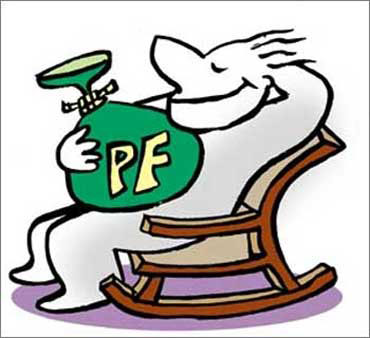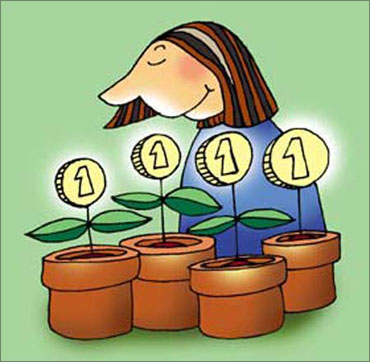 | « Back to article | Print this article |
The best tax-saving schemes for you!
It's best to start your tax planning in the beginning of the year to help you systematically grow your savings coupled with the added benefit of tax saving realised at the end of the financial year.
The most popular tax saving schemes fall under Section 80C of the Income Tax Act. Under this section, this year too a deduction of up to Rs 100,000 is allowed from taxable income in respect of investments made in some specified schemes.
This may change to Rs 300,000 from April 1, 2011, once the new Direct Taxes Code kicks in to place.
Meanwhile, let's focus on this year and see how you can make the best of Section 80C.
Click NEXT to read on. . .
The best tax-saving schemes for you!
Eligible schemes under section 80C for 2010-2011
The Specified Investment Schemes u/s 80C and u/s 80CCC are:
1. Life Insurance Premiums
2. Contributions to Employees Provident Fund
3. Public Provident Fund
4. NSC (National Savings Certificates)
5. Unit Linked Insurance Plan (ULIP)
6. Repayment of Housing Loan (Principal)
7. Equity Linked Savings Scheme (ELSS) of Mutual Funds
8. Tuition Fees including admission fees or college fees paid for full-time education of any two children of the tax payer.
9. Infrastructure Bonds issued by Institutions/ Banks such as IDBI, ICICI, REC, PFC, etc.
10. Pension scheme of LIC of India or any other insurance company.
11. Fixed Deposit with Banks having a lock-in period of five years.
This article will discuss the details of all the above plans.
Click NEXT to read on. . .
The best tax-saving schemes for you!
Life insurance premiums
An amount up to Rs 100,000 that you pay towards your life insurance premium for yourself, your spouse or your children can be included in Section 80C deduction.
Life insurance premium paid for your parents or your in-laws is not eligible for deduction.
If you are paying premium for more than one insurance policy, all the premiums can be included. It is not necessary to have the insurance policy only from Life Insurance Corporation; even insurance bought from private companies can be considered. All plans like endowment, money-back plans and term plans are eligible for the deduction.
You can also seek exemption from gross income under Section 10 (10) D for any sum received from insurance policy as maturity proceeds. Death benefits are exempt from tax.
Click NEXT to read on. . .
The best tax-saving schemes for you!
Employee Provident Fund (EPF)
The EPF is a scheme intended to help employees from both private and non-pensionable public sectors save a fraction of their salary every month in a savings scheme, to be used in an event that the employee is temporarily or no longer fit to work or at retirement.
A member of the provident fund can withdraw full amount at the credit in the fund on retirement from service after attaining the age of 55 year.
Full amount in provident fund can also be withdrawn by the member under the following circumstance:
A member is retired on account of permanent and total disablement due to bodily or mental infirmity.
On migration from India for permanent settlement abroad or for taking employment abroad.
In the case of mass or individual retrenchment.
EPF is automatically deducted from your salary. Both you and your employer contribute to it. While employer's contribution is exempt from tax, your contribution (i.e., employee's contribution) is counted towards section 80C investments.
You also have the option to contribute additional amounts through voluntary contributions (VPF).
Current rate of interest is 8.5% per annum (p.a.) and is tax-free. Also, apart from saving tax now, it builds a long term, tax-free retirement corpus for you.
The EPF is fully exempted at all stages -- investment, growth and withdrawal, but from April 2011 it might be taxed at the time of withdrawal.
Click NEXT to read on. . .
The best tax-saving schemes for you!
Public Provident Fund
Public Provident Fund is a tax saving investment, the interest earned is also tax free. It is a scheme run by the Government of India, and it is also totally safe.
The interest paid is 8% compounded annually and the minimum investment is Rs 500 and the maximum investment is Rs 70,000. It is a long-term investment option (minimum 15 years with option to extend it for any number of 5 year periods) as the interest is fully exempted from tax.
The PPF is fully exempted at all stages -- investment, growth and withdrawal, but from April 2011 it might be taxed at the time of withdrawal.
The unique feature of PPF is that in case of insolvency it will not be attached to the assets of the insolvent. So this is an attractive tax saving tool for business people in fluctuating and highly leveraged businesses.
Click NEXT to read on. . .
The best tax-saving schemes for you!
National Savings Certificate
It is a good medium term investment option. National Savings Certificate (NSC) is a 6-year small savings instrument eligible for section 80C tax benefit. Rate of interest is 8 per cent compounded half-yearly, i.e., the effective annual rate of interest is 8.16%. If you invest Rs 1,000, it becomes Rs 1,601 after six years.
The interest accrued every year is liable to tax (i.e., to be included in your taxable income) but the interest is also deemed to be reinvested and thus eligible for section 80C deduction.
An advantage of the NSC is that it can be pledged as security against a loan to banks/ government institutions. The minimum investment starts from Rs 100 and there is no maximum limit for the investment.
Unit-Linked Insurance Plan
Unit-Linked Insurance Plan (ULIP) is life insurance solution that provides for the benefits of risk protection and flexibility in investment. Part of the premium you pay goes towards the sum assured (amount you get in a life insurance policy) and the balance will be invested in whichever investments you desire - equity, debt or a mixture of both.
The investment is denoted as units and is represented by the value that it has attained called as Net Asset Value (NAV).
The fund value at any time varies according to the value of the underlying assets at the time. This is similar to mutual funds.
ULIP provides solutions for insurance planning, financial needs, and many types of financial planning including children's marriage planning.
The tax benefit for life insurance plans also extend to the time of maturity and in case of death claim under Section 10(10)D. However for ULIPs the maturity benefit is tax free only if the premium paid per year is less the 20% of the life insurance cover. In other words the life cover has to be at least 5 times the premium.
As per the new Direct Taxes Code (which will come into force from April 1, 2011) this benefit will be available only if the life cover is 20 times the premium.
Click NEXT to read on. . .
The best tax-saving schemes for you!
Repayment of housing loan
The EMI (equated monthly instalment) that you pay to repay your home loan consists of two components -- one is the principal and the other is the interest. The principal component of the EMI qualifies for deduction under section 80C. Even the interest component can save you significant income tax -- but that would be under Section 24 of the Income Tax Act.
Currently, anybody with a housing loan gets a deduction up to Rs 150,000, paid as interest for the loan, from his total income.
The Direct Taxes Code proposal relating to housing loans, if implemented, will deal a severe blow to home loan customers. This is because after April 1, 2011, the tax benefit that a customer receives due to the deduction in his income for the interest paid on his housing loan will be abolished.
Click NEXT to read on. . .
The best tax-saving schemes for you!
Equity-linked Savings Scheme (ELSS) of mutual funds
The advantage with ELSS is that the lock-in period is only for 3 years while for NSC it is 6 years and for PPF it is 15 years.
The last 5 years' return from ELSS has been in the range of 23 to 25% compounded annually compared to 8% in NSC and PPF. The limitations in ELSS are that premature withdrawal is not allowed and the risk factor is high when compared with the NSC and PPF.
Infrastructure bonds
Deduction will be available for all taxpayers who invest up to Rs 20,000 in long-term infrastructure bonds as announced in the Budget 2010-11. This amount is over and above the Rs 100,000 limit under section 80C.
The returns that these bonds will give are not clear at present, as they have not been in the market for the past five years.
However, returns in the range of 6 to 8% can be expected. You can expect these bonds to be in the market during the tax saving season -- December 2010 to March 2011. Typically these bonds will have a lock-in period of 3 to 5 years.
Click NEXT to read on. . .
The best tax-saving schemes for you!
Pension plans
Today pension plans are available with all life insurance companies. They typically come without any life cover (zero death benefit).
Pension funds are exempted under Section 80CCC, this section stipulates that an investment in pension funds is eligible for deduction from the income.
Section 80CCC investment limit is clubbed with the limit of Section 80C which means that the total deduction available for 80CCC and 80C is Rs 100,000. This also means that your investment in pension funds up to Rs 100,000 can be claimed as deduction u/s 80CCC.
Of the maturity amount only one-third can be commuted in cash as tax free maturity. The rest of the amount (or the full amount as the case may be) has to be used to by a pension plan (annuity).
Recently, the Insurance Regulatory and Development Authority (IRDA) has come out with a clear rule that maturity amount should not be withdrawn as cash this is coming to effect from July 1, 2010.
Currently, the maturity amount can be withdrawn as cash but the amount will be added to income and will be taxed accordingly.
Click NEXT to read on. . .
The best tax-saving schemes for you!
5-year tax-saving bank deposit
A fixed deposit is meant for those investors who want to deposit a lump sum of money for a fixed period; say for a minimum period of 15 days to five years and above. Investor gets a lump sum (principal + interest) at the maturity of the deposit.
The 5-year tax-saving bank deposit gives tax benefit under Section 80C. The typical interest rate is 8% with an additional 0.25 to 0.5% for senior citizens. The interest rate varies between banks and with time.
So, one needs to check with several banks to get a good offer. But once the deposit is made the rate remains constant for the five years. This is a limitation for the tax saver.
The new Direct Taxes Code will shift India to the Exempt-Exempt-Tax regime from the Exempt-Exempt-Exempt regime. This being the last year before the implementation of the EET system, tax savers have to be careful in the choice for their tax saving investments.
Powered by
BankBazaar.com is an online marketplace where you can instantly get loan rate quotes, compare and apply online for your personal loan, home loan and credit card needs from India's leading banks and NBFCs.
Copyright 2025 www.BankBazaar.com. All rights reserved.









